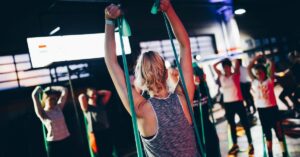The Essential Mobility Secrets Every Athlete Should Know for Injury Prevention

The Essential Mobility Secrets Every Athlete Should Know for Injury Prevention
Every athlete, whether a weekend warrior or a seasoned pro, has felt the sting of an injury at some point. It’s a rite of passage, almost like a badge of honor—except it’s not exactly the kind of honor you want to brag about at dinner parties. I remember my first serious setback: a hamstring strain that sidelined me for weeks. As I sat on the couch, binge-watching yet another crime drama, it struck me: how could I have prevented this? This question led me down a rabbit hole of research, and what I found was both enlightening and, dare I say, vital for anyone looking to stay in the game.
Mobility is the unsung hero in the world of injury prevention. While many athletes focus on strength training and cardiovascular endurance, they often overlook the importance of maintaining and enhancing mobility. So, let’s dive into the essential secrets of mobility and how they can save you from the clutches of injury.
Understanding Mobility: More Than Just Stretching
First things first: let’s clarify what we mean by mobility. It’s a term that gets thrown around a lot, often interchangeably with flexibility, but they’re not quite the same thing. Mobility refers to the ability of a joint to move through its full range of motion, while flexibility is about the length of the muscle. Think of mobility as a dance between your muscles and joints, where both need to be in sync to perform a flawless routine—kind of like a well-rehearsed pas de deux, but with fewer tutus and more sweat.
The Importance of Joint Mobility
Joint mobility is foundational for athletic performance. When joints can move freely, athletes can execute movements with precision and power. Think about it: if your hip joint is stiff, every sprint, jump, or lateral movement becomes a gamble. You’re setting yourself up for potential disaster (and not the fun kind). Some studies suggest that inadequate joint mobility can lead to compensatory movement patterns, which can stress other areas of the body and increase the risk of injury.
Secrets to Improving Mobility
Now that we’ve established why mobility is crucial, let’s delve into some strategies to enhance it. Spoiler alert: it’s not all about static stretching before a workout. That’s so last decade.
Dynamic Warm-Ups Are Your Best Friend
If you’re still doing static stretches before your workouts, it’s time for a reality check. Dynamic warm-ups are where it’s at. These involve movements that mimic the activity you’re about to perform, gradually increasing your heart rate and loosening up your muscles and joints. It’s like a gentle nudge to your body, saying, “Hey, let’s get ready to work!”
Some great dynamic warm-up exercises include:
- Leg swings (forward and sideways)
- Arm circles
- Lunges with a twist
- Hip circles
- High knees or butt kicks
These exercises can help to improve your range of motion significantly. I once stumbled upon a particularly intense dynamic warm-up session led by a former Olympic coach—it was a revelation! I felt like a rubber band, ready to snap back into action.
Incorporating Mobility Drills into Your Routine
To really boost your mobility, you’ll want to integrate specific mobility drills into your training regimen. These drills target different joints and muscle groups, promoting flexibility and strength. Here are a few to get you started:
1. Hip Flexor Stretch
This is a game-changer for athletes who sit for long periods (hello, desk jobs!). Kneel on one knee with the other foot in front, and gently push your hips forward. You should feel a nice stretch in the hip flexor of the kneeling leg. Hold for 20-30 seconds before switching sides.
2. Thoracic Spine Rotation
Many athletes neglect their upper back, which can lead to poor posture and limited shoulder mobility. While kneeling or sitting, place one hand behind your head and rotate your torso, keeping your hips stable. This move is great for improving upper body rotation, which is essential for sports like baseball or golf.
3. Ankle Mobility Drill
Let’s not forget about the ankles! Stand facing a wall, and place one foot a few inches back. Bend your front knee toward the wall while keeping your heel on the ground. This will enhance your ankle flexibility and stability—crucial for running, jumping, and just about everything else.
Consistency is Key
Now, here’s the kicker: you can’t just do these drills once and expect to transform into a mobility master overnight. Consistency is key! I learned this the hard way when I diligently practiced my mobility routine for a week, then promptly forgot about it for a month. The result? Back to square one—my body reminding me that I had neglected it. It’s like watering a plant; miss a few days and you’ll see the consequences!
Making Mobility a Habit
To integrate mobility work into your routine, consider the following strategies:
- Set specific goals: Aim for a certain number of mobility sessions each week.
- Pair it with other workouts: Do your mobility drills after your strength training or cardio sessions.
- Track your progress: Keep a journal of your mobility exercises and how they make you feel.
- Find a buddy: Having a training partner can add a layer of accountability.
For me, I started doing my mobility drills while watching TV—multitasking at its finest! It became a routine that I could stick to, and the results were worth it.
Listening to Your Body
It’s essential to listen to your body as you work on your mobility. If something feels off, it probably is. Athletes often push through discomfort, thinking it’s a sign of toughness. But there’s a fine line between pushing limits and risking injury. We’ve all seen that athlete who refuses to take a break until they’re limping, and it’s never a pretty sight.
Recognizing the Signs
So, what should you be on the lookout for? Here are some signs that you might need to back off and focus more on mobility:
- Persistent tightness in muscles or joints
- Recurring injuries
- Decreased range of motion
- Difficulty with movements that were once easy
Take it from someone who learned the hard way: sometimes the best thing you can do is take a step back and assess your mobility routine. (Trust me, your future self will thank you.)
Cross-Training for Enhanced Mobility
Cross-training is another fantastic way to enhance your mobility. Engaging in activities outside your primary sport can help balance out muscle imbalances and improve overall mobility. For instance, if you’re a runner, try swimming or cycling. If you’re a weightlifter, consider incorporating yoga or Pilates into your routine. These activities not only promote flexibility but also allow your body to move in different ways, which can help with injury prevention.
The Magic of Yoga
Yoga is particularly beneficial for athletes looking to improve their mobility. I remember attending my first yoga class, half-expecting it to be a glorified stretching session. Instead, I found myself challenged in ways I never imagined! The focus on breath, balance, and mindful movement opened my eyes to new ranges of motion and body awareness.
Some key poses to incorporate include:
- Downward Dog
- Warrior II
- Pigeon Pose
- Cat-Cow Stretch
These poses can help you develop strength while enhancing flexibility. Plus, they give you an excuse to wear those trendy yoga pants, and who doesn’t love that?
Nutrition and Hydration: The Unsung Heroes
As odd as it may sound, mobility is also tied to what you put in your body. Proper nutrition and hydration play crucial roles in keeping your muscles and joints healthy. Dehydrated muscles are like a rubber band that’s been left in the sun—brittle and prone to snapping. Make sure you’re consuming enough water, especially during training sessions, and fuel your body with a balanced diet rich in vitamins and minerals.
Foods for Mobility
Some foods can specifically help promote joint health and enhance mobility:
- Fatty fish (think salmon and sardines) for omega-3 fatty acids
- Nuts and seeds for healthy fats and vitamin E
- Leafy greens for antioxidants
- Fruits like berries and cherries, which can reduce inflammation
Incorporating these foods into your diet can help keep your joints lubricated and functioning smoothly. And let’s be honest—who doesn’t want an excuse to eat more avocado toast?
Rest and Recovery: The Often-Overlooked Component
Ah, rest. The word itself can feel like a luxury that many athletes are reluctant to embrace. But recovery is critical for improving mobility and preventing injuries. Your body needs time to repair and rebuild, and without adequate rest, you’re only setting yourself up for failure. I once had a teammate who thought sleep was for the weak—until a series of injuries made him rethink his life choices. Lesson learned: listen to your body!
Active Recovery Techniques
Active recovery involves low-intensity activities that promote blood flow and aid in muscle recovery without adding extra strain. Some effective active recovery techniques include:
- Gentle walking or cycling
- Swimming
- Foam rolling
- Stretching sessions
Integrating these practices into your routine can help you maintain mobility while allowing your body to recover properly. Plus, foam rolling can be surprisingly therapeutic—just don’t be shocked if you end up making an odd face while rolling out those knots!
Involving a Professional: When in Doubt, Seek Help
Sometimes, it’s best to consult a professional. Physical therapists, trainers, or mobility specialists can provide tailored advice and exercises to address specific needs. They can assess your movement patterns and identify areas for improvement, helping you develop a comprehensive mobility plan.
What to Expect from a Mobility Assessment
When working with a professional, they may conduct a mobility assessment that includes:
- Range of motion tests for different joints
- Strength assessments
- Posture analysis
- Movement pattern evaluations
After the assessment, they’ll likely provide you with a personalized plan that includes targeted exercises, mobility drills, and advice on how to integrate these into your training routine. I once had a physical therapist who was like a magician with mobility—she had me doing things I never thought possible!
Conclusion: Take Charge of Your Mobility
In the end, mobility is more than just a buzzword; it’s a critical component of athletic performance and injury prevention. By prioritizing mobility, you can unlock your body’s potential, enhance your performance, and, most importantly, keep yourself in the game. So, whether you’re a seasoned athlete or just starting out, remember that investing time and effort into your mobility can pay dividends in the long run. Your future self will thank you (and maybe even reward you with a few extra years of play). Now, go out there and stretch it out—you’ve got this!







